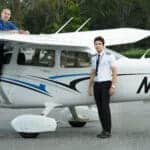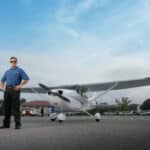Private Pilot License India: #1 Ultimate Guide to Cost, Eligibility & Training

A Private Pilot License India (PPL) is the foundational certification that allows individuals to fly aircraft for non-commercial purposes under visual flight rules. Issued by the Directorate General of Civil Aviation (DGCA), this license is designed for aviation enthusiasts, private aircraft owners, and aspiring commercial pilots who want to build flight experience before advancing to a CPL.
The PPL is not intended for paid flying roles but grants the holder legal permission to act as pilot-in-command of a single-engine aircraft for personal or recreational use. It’s also a critical first step for those planning a long-term aviation career, as the hours logged during PPL training are counted toward the requirements for a Commercial Pilot License.
Whether you’re exploring aviation as a serious hobby or preparing for professional pilot training, enrolling in a Private Pilot License India program provides essential skills in aircraft handling, navigation, airspace communication, and flight safety—all under the framework of DGCA regulations.
DGCA Requirements for Private Pilot License India
To begin training for a Private Pilot License India, candidates must meet specific eligibility criteria set by the Directorate General of Civil Aviation (DGCA). These requirements ensure that students are medically, academically, and linguistically prepared for pilot training.
Minimum Age: Applicants must be at least 17 years old at the time of license issuance. Some academies may allow earlier enrollment, but the license is not granted before the age threshold.
Educational Qualification: A minimum of 10th-grade pass or equivalent is required. Students are expected to demonstrate basic proficiency in mathematics and physics, though these are not mandatory at this stage.
DGCA Class 2 Medical Certificate: Candidates must undergo a medical examination by a DGCA-approved doctor to obtain a Class 2 medical certificate. This includes checks for vision, hearing, cardiovascular health, and general fitness.
English Proficiency: Since aviation communication is conducted in English, students must demonstrate Level 4 English proficiency, as per DGCA guidelines. This may involve a language assessment during training.
Approved Flight School Enrollment: Training must be conducted at a DGCA-approved flying school in India. These schools adhere to standardized procedures, safety protocols, and curriculum structures outlined by DGCA.
Meeting these Private Pilot License India requirements is mandatory before any flight training can begin, and all documents are verified prior to examination and licensing.
Course Structure & Training Phases
The training for a Private Pilot License India is divided into two core components: ground school and flight training. Both must be completed through a DGCA-approved academy like the Florida Flyers Flight Academy India to ensure eligibility for licensing.
Ground School forms the theoretical foundation. This phase typically lasts 1–2 months and covers:
- Air Navigation – how to read aeronautical charts and plan routes
- Meteorology – interpreting weather conditions and forecasts
- Air Regulation – DGCA rules, flight rules, and operational procedures
- Technical General – understanding aircraft systems and performance
- Radio Telephony (RT) – essential communication with air traffic control
Students must pass written exams for each subject, administered under DGCA oversight.
Flight Training follows, requiring a minimum of 40–50 flying hours. These hours are broken into:
- Dual Flights with an instructor to learn basic control and maneuvers
- Solo Flights where students fly independently under supervision
- Cross-Country Navigation to test in-flight decision-making and planning
- Night and Check Flights, if applicable, leading up to the final skill test
The course concludes with a flying skill test conducted by a DGCA-appointed examiner. This practical exam evaluates handling, navigation, emergency response, and communication in live conditions.
Together, these phases equip students with both the knowledge and flying experience required to operate an aircraft safely under visual flight rules—forming the core of the Private Pilot License India training journey.
How Long Does It Take to Get a PPL in India?
The typical timeframe to complete a Private Pilot License India is 3 to 6 months for full-time students. This includes both ground school and flight training, assuming consistent weather conditions and aircraft availability.
However, the actual duration can vary based on a few key factors:
- Aircraft and instructor availability – delays may occur if the academy has a limited fleet or instructor schedule
- Weather disruptions – training may be paused during monsoon or fog-heavy months, especially in northern India
- Student readiness – slower progress in ground theory or delayed exam attempts can stretch the timeline
Some DGCA-approved academies also offer part-time or weekend training formats, ideal for working professionals or students balancing other commitments. These programs typically extend the course duration to 6 to 12 months, depending on attendance frequency.
Cost of Private Pilot License India (2025)
Pursuing a Private Pilot License India involves a moderate financial investment, typically ranging from ₹7.5 lakhs to ₹11 lakhs, depending on the academy’s location, aircraft type, and service inclusions.
Here’s a cost breakdown for 2025:
| Component | Estimated Cost (INR) |
|---|---|
| Ground School | ₹50,000 – ₹1,50,000 |
| Flight Training (40–50 hrs) | ₹6,00,000 – ₹9,00,000 |
| Medicals (Class 2) | ₹4,000 – ₹7,000 |
| Exam & DGCA License Fees | ₹15,000 – ₹25,000 |
| Study Materials & Uniform | ₹20,000 – ₹40,000 |
Total Estimated Range: ₹7.5 lakhs – ₹11 lakhs
Additional costs may apply if:
- Students require extra flight hours beyond the 50-hour threshold
- Re-tests are needed for DGCA theory exams or skill checks
- The academy is based in a metro city where accommodation and training costs are higher
Some academies offer installment plans or help connect students with education loan providers to ease financial pressure.
Top Flight Schools in India for PPL Training
When pursuing a Private Pilot License India, the quality of your training environment plays a vital role in both learning outcomes and long-term safety. While several DGCA-approved schools across India offer PPL training, a few stand out for their infrastructure, faculty experience, and overall reputation.
Florida Flyers Flight Academy India ranks among the leading choices. With its DGCA-approved curriculum, a modern fleet of training aircraft, and experienced instructors, the academy provides students with a structured and reliable learning experience. The school’s dual presence in India and the U.S. offers an added advantage for students who may want global exposure.
Other reputable institutions include:
- Indira Gandhi Institute of Aeronautics (IGIA) in Chandigarh, known for its experienced faculty and strong safety culture
- Madhya Pradesh Flying Club in Indore, one of India’s oldest and most affordable public flight schools
- Government Aviation Training Institute (GATI) in Bhubaneswar, offering extensive airspace access and minimal weather delays
- Bombay Flying Club, based in Mumbai, with a historic legacy and urban location convenient for metro-based students
When evaluating flight schools, consider the following:
- Is the academy DGCA-approved with a current license to offer PPL training?
- What is the condition and variety of the fleet?
- Does the training location offer favorable weather for consistent flying?
- Are instructors qualified with strong training or airline experience?
- What is the school’s safety and licensing track record?
The right school will not only help you earn your license but also prepare you for the higher demands of future aviation training.
Benefits of Holding a Private Pilot License India
Earning a Private Pilot License India opens a range of opportunities beyond just flying for fun. While the license doesn’t permit commercial operations, it grants access to a world of private aviation privileges.
For recreational pilots, a PPL allows you to fly solo or with passengers anywhere within Indian airspace under visual flight rules (VFR). Many private aircraft owners use their PPLs to travel independently across states or enjoy aviation as a hobby.
A PPL also serves as the first stepping stone toward professional training. Hours logged during your private pilot training count toward your Commercial Pilot License (CPL) requirements, significantly reducing the cost and time needed later.
International opportunities are also available. Indian PPL holders can often convert their license to FAA (USA), EASA (Europe), or other ICAO-member country equivalents—typically by clearing written exams and local validations.
In short, a PPL gives you:
- Freedom to fly for personal or non-commercial use
- Foundational skills and airspace knowledge
- A valuable head start toward advanced licenses like CPL and ATPL
- Access to international aviation pathways
Steps to Get a Private Pilot License India
Earning a Private Pilot License in India involves a clear, structured process governed by the Directorate General of Civil Aviation (DGCA). Here’s how the journey typically unfolds:
Select a DGCA-Approved Flight School: Begin by enrolling in a certified academy recognized by the DGCA. Ensure the school offers a dedicated PPL program with qualified instructors, modern aircraft, and the infrastructure needed for consistent training.
Undergo the DGCA Class 2 Medical Examination: Before starting flight training, you must pass a Class 2 medical exam conducted by a DGCA-approved medical examiner. This confirms your physical and mental fitness to fly under visual flight rules (VFR).
Complete Ground School and Flight Training: Attend ground classes to cover essential subjects like air navigation, meteorology, air regulation, and aircraft technical knowledge. Simultaneously or thereafter, you’ll begin your flight training—logging a minimum of 40 to 50 flying hours, including solo and cross-country time.
Pass the DGCA Written Theory Exams: Once ground school is complete, you must clear DGCA-mandated written exams in each subject. These exams test your theoretical knowledge and form part of the overall licensing requirement.
Clear the PPL Flying Skill Test: After completing your flight hours, a skill test is conducted by a DGCA-appointed examiner. This check evaluates your ability to safely operate an aircraft, communicate effectively, and respond to in-flight scenarios.
Submit Your Logbook and Documents for License Issuance: Upon passing the skill test, submit your complete logbook, exam results, and identity documents to the DGCA through your flight school. Once verified, your Private Pilot License is issued.
By following these steps through a trusted institution like Florida Flyers Flight Academy India, students can complete the licensing process smoothly and confidently.
Conclusion: Take the First Step Toward the Skies
A Private Pilot License in India is more than just a certification—it’s the foundation of everything that follows in aviation. Whether your goal is to fly for leisure, train for advanced licenses, or eventually pursue a commercial career, the PPL is your official entry into the cockpit.
With the right training academy, like Florida Flyers Flight Academy India, and a clear understanding of the process, most students can complete their license in just a few months. From ground school to in-air experience, this journey equips you with real skills, regulatory knowledge, and the confidence to take flight—safely, legally, and with purpose.
FAQs: Private Pilot License India
| Question | Answer |
|---|---|
| How much does a PPL cost in India? | The cost ranges from ₹7.5 to ₹11 lakhs, depending on the academy, fleet, and location. |
| How many hours are required for a PPL? | DGCA requires a minimum of 40 flying hours, though most students complete 45–50 hours. |
| Can I fly commercial flights with a PPL? | No. A PPL allows for personal or recreational flying only—not commercial operations. |
| Is a PPL valid internationally? | Yes, it can be converted to FAA, EASA, or ICAO-member equivalents with additional exams. |
| What is the validity of a PPL in India? | It remains valid for 10 years, subject to regular medical renewals and currency requirements. |
Contact the Florida Flyers Flight Academy Team today at 91 (0) 1171 816622 to learn more about the Private Pilot Ground School Course.



Table of Contents






